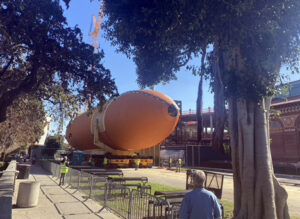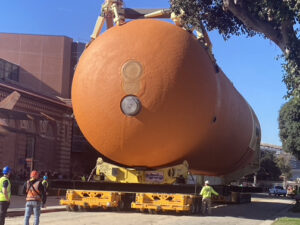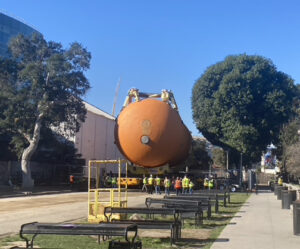
Photos by Mikaela STONE
By Mikaela STONE
The California Science Center announced all systems are “go for stack” for the space shuttle Endeavour. According to its website, “Go For Stack is the complex process of moving and lifting each of the space shuttle components into place for Endeavour’s upcoming 20-story vertical display in the future Samuel Oschin Air and Space Center, which is currently under construction.” The fuel tank, which was recently moved to the campus of the California Science Center, joins the pair of solid rocket boosters already erected in the scaffolding. The movement of the ET-94 fuel tank to the construction site occurred on the morning of Jan. 10, with the subsequent lift into place of the fuel tank occurring three days later in the early morning – a process lengthened by the elements as even winds as low as seven miles per hour make precarious crane lifting of the 76,000-pound object. From the fuel hatch at its base to the sound barrier-breaking needle on its nose, the fuel tank’s engineers have optimized every part to add as little weight as possible; even the color of the tank remains a rusty red from the insulation as painting even a thin layer of color on the 154 foot long cylinder would add hundreds of pounds. Within its orange shell, twin tanks of liquid hydrogen and liquid oxygen work together to propel the rocket before combining as water and burning away into vapor.

Because such a great length is required to store all of the rocket’s components, its movement to the construction zones was a procedure that lasted two hours to ensure the safety of onlookers and the moving crew. Museum volunteers, members and employees gathered to watch the tank roll past the Exposition Park Rose Garden as it traveled to its forever home. As the tank rolled into the sunlight and past the California Science Center sign, it encountered one last obstacle – the branches of a bay fig tree that was planted too close to the road and left no clearance for ET-94’s 27.5 foot diameter body. The Go For Stack safety crew countered this problem by laying down wooden pallets and plates of sheet metal to roll the massive tank up onto the sidewalk and around its adversary. On the bed of a specially made hauling vehicle, equipped with wheels that spun in all directions and two crew members remotely piloting each side of the machinery, team members from the family-owned business Bragg Companies succeeded in safely rerouting the tank’s course – just very very slowly.

Once the stack is finally completed, it will stand 20 stories high and weigh 502,000 pounds. The Samuel Oschin Air and Space Center will open in 2025 to the public and will feature the only upright shuttle on display anywhere. Science Center CEO Jeffrey N. Rudolph hopes that the Endeavour, as the “centerpiece” of the Air and Space Center, will inspire “people, particularly young people, from LA and around the world to learn about science and engineering and hopefully consider pursuing additional education and careers.” Rudolph himself has personal experience with the uplifting power of the California Science Center from visiting as a child.
The new air and space center, named after philanthropist Samuel Oschin for his financial contributions to space research, will include over one hundred exhibits. Many of these will allow guests tactile exploration with hands-on activities that is spread over three exhibit themes: air, space, and shuttle. The Air Gallery will focus on how natural forces, such as lift, thrust, drag and weight, affect aircraft by teaching how designs are affected by them and by allowing guests to experiment in a wind tunnel lab.
The Space Gallery will focus on inventions that have revolutionized humanity’s knowledge of space. These include robots, from rovers to telescopes such as the Hubble. While many necessary pieces of space-bound machinery, such as the external fuel tanks, are designed to burn up in the atmosphere, the Space Gallery will offer a menu of both flown and unflown spacecraft, including planetary probes and the flown Gemini 11 space capsule, among many others.
Finally, the Shuttle Gallery will allow guests to see up close the Endeavour and its fuel tanks.
Once all components of Endeavour are in place, the Samuel Oschin Air and Space Center will be built around it. Completion of the Center is estimated in several years.
